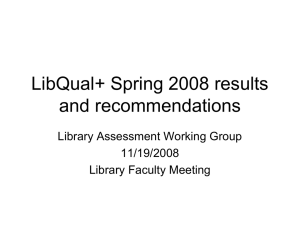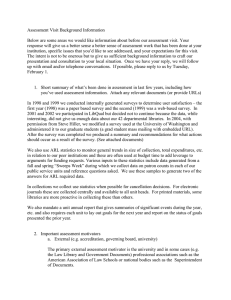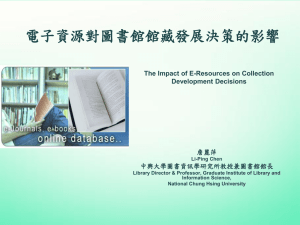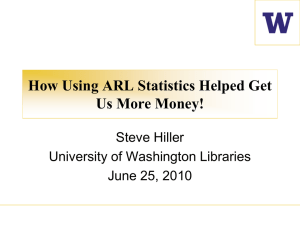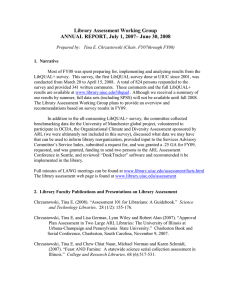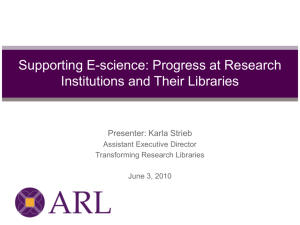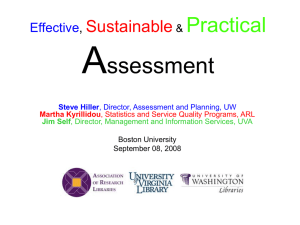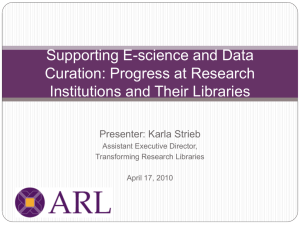OLA Services Assessment
advertisement
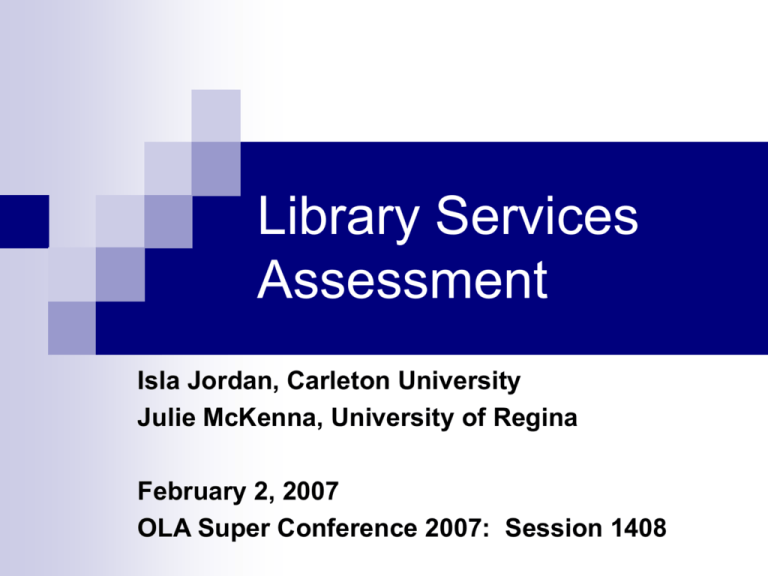
Library Services Assessment Isla Jordan, Carleton University Julie McKenna, University of Regina February 2, 2007 OLA Super Conference 2007: Session 1408 Outline 1. 2. 3. 4. 5. 6. 7. 8. Definition and Purpose Survey of Assessment Practices Types of Assessment Benchmarks, Standards and EBL Drivers of Assessment Tools and Techniques Assessment strategy Questions Assessment … a critical tool for understanding library customers and offering services, spaces, collections, and tools that best meet their needs. Without good assessment, libraries could lose touch with users’ desires and needs and even become irrelevant. Nardini (2001) Assessment …any activities that seek to measure the library’s impact on teaching, learning and research as well as initiatives that seek to identify user needs or gauge user satisfaction or perceptions with the overall goal being the data-based and user-centered continuous improvement of our collections and services. Pam Ryan, libraryassessment.info The purpose of assessment in libraries 1. 2. To understand user interaction with library resources and services; and To capture data that inform the planning, management and implementation of library resources and services. Bertot, 2004 Survey of Assessment Practices in Canadian University Libraries Winter 2007 Survey of Assessment Practices - Purpose 1. 2. Benchmark services assessment practice Capture some measures about the culture of assessment Survey Sections Demographic Information Assessment Planning Involvement in Assessment in Organization Collection and Use of Data to Inform Decision-Making Final Comments Survey Participants Invitation to complete a web-based survey to all University Librarians of: Council of Prairie and Pacific University Libraries (COPPUL) Ontario Council of University Libraries (OCUL) Council of Atlantic University Libraries (CAUL/AUBO) Invitation (February 12, 2007) to complete a French edition of the web-based survey: members of Conférence des recteurs et des principaux des universités du Québec (CREPUQ) Survey of Assessment Practices English Survey 60 invitations; 39 respondents 65% response rate French To Survey launch February 12, 2007 Thank you to … University of Toronto UWO Queen’s University McMaster University of Windsor York University Guelph University Nipissing University University of Waterloo Carleton University Brock University Memorial University University of Saskatchewan UBC University of Alberta And many more…. Types of Assessment 1. 2. 3. 4. Input & Output Service Quality Performance Measures Outcomes or Impact 1. Input & Output Input measures: expenditures & resources Funding allocations, # of registered students, print holdings, etc. Output measures: activities & service traffic Reference transactions, lending and borrowing transactions, # of instruction sessions, program attendance, etc. Ratios Students/librarians, print volume holdings/student, reference transactions/student, etc. Survey Results – how output data is used Type of data Gate count Body counts Reference transactions Circulation statistics Decision-making Hours Staffing & scheduling Service points Collection decisions 2. Service Quality Services defined as all programs, activities, facilities, events, … Measure capture results from interactions with services Subjective evaluation of “customer service” Measure of the affective relationship “The only criteria that count in evaluating service quality are defined by customers. Only customers judge quality; all other judgments are essentially irrelevant.” (Zeithaml, Parasuraman and Berry 1990) LibQUAL+ Association of Research Libraries Standard for service quality assessment (2003) Total market survey Based in Gap Analysis Theory User perceptions and expectations of services Measures outcomes and impacts 3. Performance Measures Involves the use of efficiency and effectiveness measures Availability of resources Usability of programs, resources and services Web page analysis Content analysis Functionality analysis Cost analysis 4. Outcomes or Impacts “the ways in which library users are changed as a result of their interaction with the Library's resources and programs” Association of College & Research Libraries Task Force on Academic Library Outcomes Assessment Report, 1998 Examples The electronic journals were used by 65 scholars in the successful pursuit of a total of $1.7 million in research grants in 2004. In a 2003 study, eighty-five percent of new faculty reported that library collections were a key factor in their recruitment. LibQUAL+ Measures Outcomes The library helps me stay abreast of developments in my field(s) of interest. The library aids my advancement in my academic discipline. The library enables me to be more efficient in my academic pursuits. The library helps me distinguish between trustworthy and untrustworthy information. Benchmarks, standards and EBL Standards: “Measures that tie the value of libraries more closely to the benefits they create for their users” NISO 2001 (National Information Standards Organization) Benchmarking: improving ourselves by learning from others (UK Public Sector Benchmarking Service) Benchmarks, standards and EBL EBL (Evidence Based Librarianship): “attempts to integrate user reported, practitioner-observed and research-derived evidence as an explicit basis for decision-making.” (Booth, “Counting What Counts” 2006) Example of a Standard Example: Information Literacy Standards for Science and Engineering Technology (ACRL 2006) Standard #1: The information literate student determines the nature and extent of the information needed. Performance Indicator #3: The information literate student has a working knowledge of the literature of the field and how it is produced. Outcome #a: ... student knows how scientific, technical, and related information is formally and informally produced, organized, and disseminated. CACUL Standards Committee Goals: Add Canadian context to existing standards in college and university libraries, e.g. ACRL prepare report for CACUL AGM at CLA 2007 form new team in summer 2007 contact Jennifer Soutter jsoutter@uwindsor.ca Survey Results: Drivers of Assessment University Library Administration Need for evidence to inform planning University Administration CARL, ARL or regional lib. Consortium 92% 87% 62% 54% Multiple Methods of Listening to Customers Transactional surveys Mystery shopping New, declining, and lost-customer surveys Focus group interviews Customer advisory panels Service reviews Customer complaint, comment, and inquiry capture Total market surveys Employee field reporting Employee surveys Service operating data capture Note. A. Parasuraman. The SERVQUAL Model: Its Evolution And Current Status. (2000). Paper presented at ARL Symposium on Measuring Service Quality, Washington, D.C. Canadian Adoption of LibQUAL+: Benefits Quick, inexpensive Standardized and tested instrument and practice Data set of comparables for Canada Insight into best practices at peer institutions Build staff expertise and encourage evidence based practice and practitioners Opportunity to introduce Canadian changes to instrument User Surveys: LibSAT, LibPAS continuous customer feedback LibSAT measures satisfaction LibPAS (beta) measures performance http://www.countingopinions.com/ Usability testing gives user perspective often for website design: e.g. “user driven web portal design” (U Toronto 2006) also for physical space: e.g. “wayfinding” in library: http://www.arl.org/arldocs/stats/statsevents/laconf/2006/Kre ss.ppt Instruction Program Example -Assessment Methods Learning outcomes Program service measures (outputs) # of instruction sessions offered, requests for course specific support, # of session attendees, by discipline, by faculty member, by course, logins to library-created online tutorials, # of course pages created within university’s learning portal, etc. Student course evaluations & peer evaluations Student performance on examinations, assignments Pre- and post-test results Level of "information literacy" Qualitative and quantitative Service quality assessment LibQUAL+ (gap between expectations and perceptions) Examples Use patterns laptop loans, GIS over paper maps, eBooks… Space usage studies e.g. Learning Commons study (University of Massachusetts Amherst) Instruction and Information Literacy e.g. use of online learning modules Electronic resources assessment statistics not being systematically captured for digital collections or services need for standard measures for use of digital collections is increasingly important: to justify huge expenses of electronic collections decline in use of traditional services (reference, ILL) Electronic resources assessment COUNTER: Real-time acquisition of usage statistics: imports usage statistics from content vendors in a uniform format (COUNTER - Counting Online Usage of Networked Electronic Resources) reduces need to retrieve statistical data on a resource-by-resource basis can compare usage statistics with cost information to evaluate service benefits of e-resources Electronic resources assessment Output statistics for ScholarsPortal databases and e-journals, e.g. the number of requests for articles holdings of different aggregators, to see overlap Web logs, to see patterns of use Survey Results: Statistics electronic resources 25 20 Never Sometimes Frequently Always 15 10 5 0 Gather Analyze Survey Results: Electronic resources assessment "we are gathering e-resources stats as part of an overall journal review " “The Library is currently reviewing Scholarly Statistics, a product designed to gather and present for analysis e-resource statistics. Also under consideration is an ERM which, along with its other capabilities, will provide statistic analysis.” Electronic resources assessment “I have been busy this week with the compilation of electronic journal usage statistics for ARL. To complete Section 15 (Number of successful full-text article requests) in the Supplementary Statistics section, I am limiting myself to Counter-compliant JR1 statistics provided by the publisher. Still, I am encountering unexpected complexities. .. The JR1 format is based on an the calendar year, but the ARL statistics are reported on the budget year. This means for every publisher I have to compile two years worth of data and manipulate it.” http://www.libraryassessment.info/ Surveys, Interviews, Focus Groups Surveys quick to implement, identify issues, pick wording is critical test, test, test …. users difficult to design up anomalies over-surveyed Interviews and focus groups more scope for follow-up, explanation subjective, time-consuming Survey Results: Top 5 planned assessment studies 1. 2. 3. 4. 5. User satisfaction survey / LibQUAL Gate traffic study Electronic database use Electronic journal use Usability of the website Survey Results: Staff Abilities Strengths Formal presentations Formal reports Draw conclusions Make recommendations Project management Facilitate focus groups Weaknesses Sampling Research design Focus group research Survey design Qualitative analysis Challenges of assessment Gathering meaningful data Acquiring methodological skills Managing assessment data Organizing assessment as a core activity Interpreting data within the context of user behaviours and constraints. (Troll Covey, 2002) Survey Results: Where is assessment placed? Assessment Librarian (2 institutions) Assessment Coordinator Libraries Assessment and Statistics Coordinator Library Assessment and Information Technology Projects Coordinator Librarian, Evaluation & Analysis Manager, Evaluation & Analysis Survey Results: Who else is assigned assessment responsibility? distributed to all unit heads or team leaders (4) AULs have responsibility (6) UL or Director (3) administrative or executive officer (4) access services or circulation (3) other positions (12) Survey Results: Committees Assessment Committee Priorities and Resources Committee Statistics Committee LibQual Committee LibQUAL+ Working Group Library Services Assessment Committee Community Needs Assessment Committee PR/Communications Committee Accreditation Self-Study Steering Committee Senior Management Group Cooperative Planning Team Q. 10 Does your library have an assessment plan? 10% Yes 33% No 57% Not yet but one is in progress Q. 11 At your university, do you feel that there is greater emphasis on assessment than in previous years? 5% 21% Yes No Undecided 74% Q. 12 Do you anticipate that the impetus for assessment practice will be greater next year 8% than this year? 10% Yes No Undecided 82% Q. 13 Some see evidence-based assessment practice as a trend. Do you believe that the increasing interest in this assessment practice will continue? 13% 3% Yes 3% No Undecided Don’t agree it is a trend 81% Services Assessment Strategy “The evaluation environment is increasingly complex, and requires knowledge of multiple evaluation frameworks, methodologies, data analysis techniques, and communication skills” Note. J.T. Snead et al. Developing Best-Fit Evaluation Strategies. (2006). Paper presented at Library Assessment Conference, Virginia. Assessment – Continuing Commitment Research Question Reporting Methodology Analysis Services Assessment Strategy Decide what you need to know and why Assign priorities Confirm timelines Commit to and carry out methodologies for discovery Analysis and reporting Continuous assessment and reporting commitment Culture of Assessment is an organizational environment in which decisions are based on facts, research and analysis where services are planned and delivered in ways that maximize positive outcomes and impacts for customers and stakeholders exists in organizations where staff care to know what results they produce and how those results relate to customers’ expectations organizational mission, values, structures, and systems support behavior that is performance and learning focused. (Lakos, Phipps and Wilson, 1998-2002) Resources ARL: ARL New Measures website (background info) Canadian LibQUAL consortium summer 2007 workshop Sam Kalb kalbs@post.queensu.ca Service Quality Evaluation Academy (“boot camp”) Resources ARL (cont’d): ARL visit: “Making Library Assessment Work” 11/2 day visit from Steve Hiller and Jim Self pre-visit survey, presentation to staff, interviews, meetings, written report UWO participated - for more information, contact Margaret Martin Gardiner mgardine@uwo.ca 2006 Library Assessment Conference http://new.arl.org/stats/statsevents/laconf/index.shtml Resources Assessment blog: libraryassessment.info Journals, conferences: Performance Measurement and Metrics Evidence Based Library and Information Practice Northumbria International Conference on Performance Measures Resources Books & Papers: Blecic, D.D., Fiscella, J.B. and Wiberley, S.E.Jr. (2007) Measurement of Use of Electronic Resources: Advances in Use Statistics and Innovations in Resource Functionality, College & Research Libraries, 68 (1), 26-44. Booth, A. (2006) Counting what counts: performance measurement and evidence-based practice. Performance Measurement and Metrics, 7 (2), 63-74 Brophy, P. (2006) Measuring Library Performance: principles and techniques, London, Facet Publishing. Resources Books & Papers: Bertot, J.C. et al. (2004) Functionality, usability, and accessibility: Iterative user-centered evaluation strategies for digital libraries. Performance Measurement and Metrics, 7 (1) 17-28. Brekke, E. (1994) User surveys in ARL libraries. SPEC Kit 205, Chicago, American Library Association Covey, D.T. (2002) Academic library assessment: new duties and dilemmas, New Library World, 103 (1175/1176), 156-164. Resources Books & Papers: Lakos, A., Phipps, S. and Wilson, B. (1998-2000) Defining a “Culture of Assessment”. http://personal.anderson.ucla.edu/amos.lakos/Present /North2001/Culture-of-Assessment-2001-4.pdf Nardini, H.G. (2001) Building a Culture of Assessment, ARL Bimonthly Report, 218 (Oct 2001). http://www.arl.org/resources/pubs/br/index.shtml Resources Books & Papers: Snead, J.T. et al. (2006) Developing Best-Fit Evaluation Strategies. Library Assessment Conference, Virginia. <http://www.arl.org/stats/statsevents/laconf/06schedul e.shtml> Zeithaml, V.A., Parasuraman, A. and Berry, L.L. (1990) Delivering Quality Service: balancing customer perceptions and expectations, London, Collier Macmillan. Thank you! Questions or comments are welcome Contact us: Isla Jordan, Carleton University Isla_Jordan@carleton.ca Julie McKenna, University of Regina Julie.McKenna@uregina.ca
